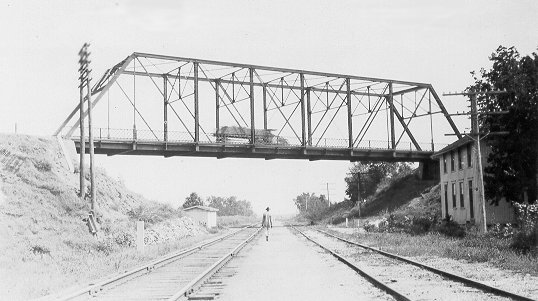|
PARKER THROUGH TRUSS
1903 LeFlore 40E1272N4707000 Pennsylvania Steel
1908 Logan 42N3124E0730004 Canton Br.
1909 Tulsa 72-Private Canton Br.
1911 LeFlore 40E1225N4775000 Missouri Valley Br.
1911 Muskogee 51-No Number Missouri Valley Br.
1912 Tulsa 72N3950E0460005 Canton Br.
1912 Tulsa 72E0490N3950008 Canton Br.
1913 McClain 44E1470N3070001 Kansas City Br.
1913 McClain 44N3070E1330004 Kansas City Br.
1915 Pottawatomie 63N3380E1350004
1916 Washington 74E0110N3930008 Rochester Br.
1919 Hughes 32-No Number Missouri Valley Br.
1921 Creek 19E0706N3860000 Concrete & Steel Co.
1922 Mayes 49E0420N4400003 Vincennes Br.
1923 Cleveland 14-No Number Missouri Valley Br.
A significant alteration made to the horizontal chord Pratt through, which mirrored changes to Pratt ponies, involved curving the upper chord, making possible longer spans, better distribution of stresses in the structure, and other advantages. The polygonal shape kept the truss depth greatest where necessary at mid-span and shallow toward the ends. Engineer C. H. Parker developed the design in the 1870s for spans over 200 feet, although builders frequently employed it, as in Oklahoma, for lengths of 140 to 225 feet. Until World War One, fabricators in Oklahoam generally preferred pinned joints, riveted ones becoming typical in the 1920s and 1930s, even as the bridge type diminished in popularity. The earlier pinned versions were supplied by the major companies, with the Kansas City Bridge Company, Missouri Valley Bridge & Iron, and Canton Bridge Company predominating in Oklahoma.
The Parkers constitute a rich resource for the state. In addition to offering some of the best examples of truss building that remain in Oklahoma, these bridges are notable as well for their cultural, technological, and aesthetic qualities. When it came to building major structures in Oklahoma during the formative years of the road system, builders chose Parker through trusses. The Kansas City Bridge Company in 1913 erected a multiple span Parker for the privately owned toll bridge on the South Canadian at Norman (Figure 8). Elsewhere, Missouri Valley Bridge & Iron recommended this type for both the calvin bridge in 1919 at a major South Canadian River crossing for highways and railroads between Oklahoma City and McAlester, and the first federal aid bridge over the same river near Newcastle, south of Oklahoma City, in 1923 (Figure 24 and Figure 26). The same preference for this bridge type in constructing major projects is evident in the Jenks Bridge, made by the Canton Bridge Company in 1909 to link Tulsa with the booming oil fields on the west side of the Arkansas River. Only a single span from this structure is believed to survive. Simular importance attended the opening of the Haskell Bridge over the Arkansas in 1911, a nine span Parker built for the county by Missouri Valley Bridge & Iron to connect Muskogee and Tulsa. In these cases, along with several others that could be cited, the Parker was selected for its strength and efficiency, although the polygonal top chord lent it a graceful air not present in other types (Figure 62).

Figure 62. A 1909 Parker through truss, that once formed a part of the Jenks Bridge across the Arkansas River, now makes a splendid entrance to a mobile home park in Tulsa.
When constructed out of heavier materials, the Parker found acceptance as a railroad bridge. In 1903 the Pennsylvania Steel Company, which worked almost exclusively for the railroads, erected a 203-foot span over the Poteau River for the Midland Valley Railroad then pushing its line towards Muskogee. A premier example of an engineered structure, it has been converted into a highway bridge for motorists at Panama, demonstrating an excellent way to make practical use of an old bridge while preserving a piece of the area's history (Figure 3).
|



